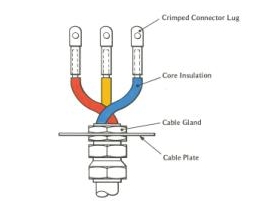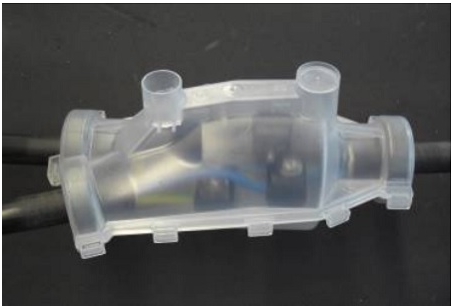Let’s go back to basics with this article by A.N, an experimented member of the community. He chose to focus on electrical cable joints and we’re glad he did!
If you too want to publish on the blog, send us a mail so that we can discuss.
Electrical joints and terminations provide the required electrical connection as well as the mechanical support, and physical protection of the cable.
There are different types of joints and terminations based on the function, type of cable and construction materials.
The design is usually influenced by the voltage and current that the cable will carry and the operational environment.
Electrical power cable terminations
The electrical cable termination is the physical and electrical connection of a cable end that connects to another cable, or to the terminal of the equipment. The cable terminations are often designed to enable the physical and electrical interconnecting of two cable ends, or a cable end and a terminal on the equipment.

Figure 1: Low voltage cable termination | image: emadrlc.blogspot.co.ke
The electrical connection requirements relate to the voltage drop, current carrying capacity, compatibility of the materials, etc. The physical requirements relate to the environmental protection as well mechanical security.
The methods used to terminate the cables vary according to the type of cable, type of connector and application. The common type of terminations are crimp connection, soldered connection, compression termination, and wire-wrapping connection, direct connection, loop or eye connection. Some of the factors that determine the type are:
- Outdoor or indoor use
- Voltage
- Current
- Overhead, or underground
- Type of Connector on the equipment where the cable will be connected.
Electrical power cable joints
The cable joints are used to connect low, medium or high voltage cables. The type of cable joint sizes, shapes and configurations vary according to the voltage, structure, insulation and the number of cores of the cable to be jointed.
The joints provide electrical insulation as well as mechanical protection and strength. The electrical connection is made in various ways and can crimping, or use of mechanical connectors, soldering, etc.
Voltage:
The joints are designed for low, medium or high voltages and it is important to match the capacity of the joint to that of the cable otherwise a low power cable joint will fail if subjected to high current.
Structure:
The cable joints are made according to how the cables are to be connected. The simple joints such as the straight through connectors are used to connect two power cables at one point while the other more advanced branch connectors may be used to accommodate a cable branching off the main line or several cables coming into one joint to form one main cable.
Cores:
The cable joints are required to have the same number of cores to those of the cables to be joined.
Insulation:
There are different cable insulations depending on the application of the cable and the cable joint must be compatible with the cable insulation.
To maintain insulation of the jointed cables, there are a variety of insulation procedures, and can be either heat or cold shrinkable insulation, r molded type of insulation, or use of tape.
Types of electrical power cable joints
There are about four commonly used types of joints; these differ in mechanical arrangement and where they are used. However, some manufacturers may provide custom designs to suit unique customer requirements.
- Straight through joints
- Branch which can be a T or Y joint
- Pot ends
- Indoor/Outdoor terminations
Straight Through joints
This is the mostly used type of a joint and is used to extend pieces of electrical cables. A typical joint is as shown in figure 2 below:

image: Multimedia.3m.com
- Riser
- Earth continuity connection
- C.J compound
- Plastinet
- Pouring gate
- Core Insulation
- PVC (NA) Tape
- Ferrule
- BOPP Tape two layers each half overlapped over plastinet
Straight joints can be used for indoor, outdoor, submerged and underground cable jointing. In the cast resin based cable joints, the polyurethane based casting resins provide mechanical protection, electrical insulation and moisture imperviousness to the joint.
Y and T type branch joint
A typical Y type branch joint is as shown in figure 3 below. This is used to join low voltage, polymeric, non-shielded cables of between 1 and 5 cores. The branch jointing provides a reliable electrical connection, electrical insulation and mechanical protection.
The connectors are either the compression or the mechanical type. The branch joints can be used for indoor, outdoor, submerged and underground cable jointing.

Figure 3: Y type Brach joint | image: http://www.cablejoints.co.uk
The design has a mold body construction with seals and fixing clips. This makes it easy to do the jointing while the sealing eliminates the need to tape the joint.
Pot End Joints
The pot end joints are used at the live voltage cable ends. In a typical cable, each of the cores is sealed separately using a heat shrink cable end caps. A screen bandage is then applied to provide for earth fault protection and the combination is then covered with a thick wall of heat shrink cable cap.
The pot ends joints are suitable for temporary and permanent cable abandonment to provide safe termination of live power cables for indoor, outdoor as well as underground cables.
Summary
The cable joints and terminations provide a means of making reliable electrical connections between different cables or between the electrical cable and the terminals of equipment. There are several standard type of cable joints and terminations, however, manufactures can make tailor made joints to suit different technical requirements.
The requirement for joints and terminations is that they should meet the standards in terms of electrical and mechanical properties, insulation, earth continuity, environmental protection and more.
A.N.
Did this article help you? Let’s discuss below!
This is a great achievement to the engineering society. keep it UP
This is a great help for all engineering society. keep it UP
Hi i have 29.1kw 3phase motor with a power factor of 0.8 and full load current is 53A. And the distance from panel to motor is 98 meters. Plz help me is cable size selection and the cable is temp resistant as well. Also show me the method of selection.
you can use 25sq mm 4 core copper cable or 16 sqmm 4 core alluminium cable
okay. so our old teacher is telling us to search for these kidn of stuff. and yeah. fuck her. i hate her so much. if i could just tell her that she is just so fucking dumb and not that good. like think of this, he gives us hard tests without her teaching us. like HELL YEAH!!
It is nice information, good way of diffrenciation,clear and precise
I need to use 100-200 pcs of this type of joints so please give more details to buy it. I will use for 600 volts CV cable. Please advise. Thanks.
Y and T type branch joint
A typical Y type branch joint is as shown in figure 3 below. This is used to join low voltage, polymeric, non-shielded cables of between 1 and 5 cores. The branch jointing provides a reliable electrical connection, electrical insulation and mechanical protection.
The connectors are either the compression or the mechanical type. The branch joints can be used for indoor, outdoor, submerged and underground cable jointing.
Y type Brach joint
Figure 3: Y type Brach joint
its informative. Good work!
Please let me know if you’re looking for a article author for your blog.
You have some really good articles and I feel I would be a good asset.
If you ever want to take some of the load off, I’d absolutely love to write some articles
for your blog in exchange for a link back to mine.
Please shoot me an email if interested. Regards!
[…] use cables of different sizes and types together. But, you require proper guidance to know which termination methods will not result in high electrical resistance. It is for that reason that you need working with a […]